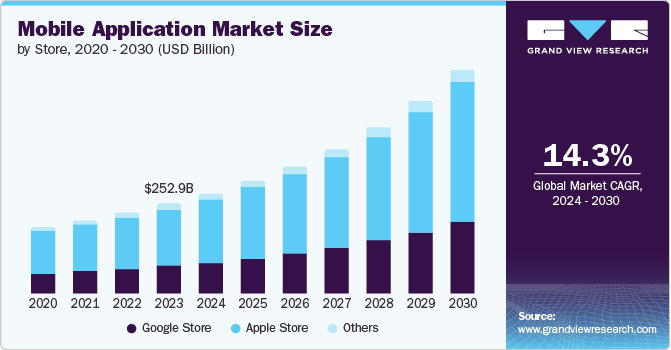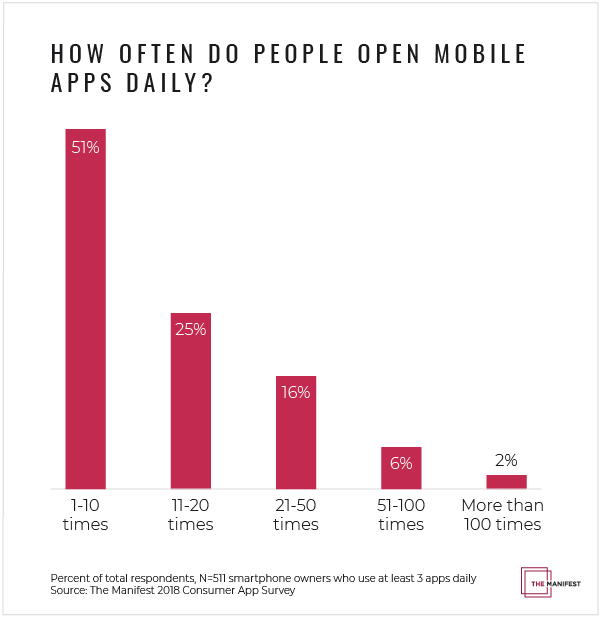Application development has emerged as a vital component of business strategy across industries. With the rapid proliferation of smartphones and mobile devices, organizations are increasingly recognizing the necessity of creating mobile applications. This is to engage users and enhance operational efficiency. Let’s find some eye-opening details of the application development market. Furthermore, examining its size, growth trajectory, notable statistics, and the key industries contributing to its evolution.
Understanding the Size of the Mobile Application Development Market
The mobile application development services market is vast and continuously expanding. In 2023, the worldwide mobile application market was valued at USD 252.89 billion and is anticipated to expand at a compound annual growth rate (CAGR) of 14.3% between 2024 and 2030. This significant growth underscores the increasing reliance on mobile applications across various sectors, driving businesses to invest in tailored solutions.

The Growth Rate of the Application Development Market
The application development market is experiencing rapid growth, fueled by technological advancements and changing consumer behaviors. The rise in mobile device usage and internet penetration has created a fertile environment for app development. Factors contributing to this growth include:
- Increased Smartphone Adoption: As of 2023, there were approximately 7 billion smartphone users worldwide. A figure expected to reach 7.7 billion by 2028. This massive user base drives demand for diverse mobile applications.
- Growing Internet Connectivity: The expansion of 5G networks and improved internet access globally. This enables the development of more sophisticated applications that require higher bandwidth and faster speeds.
- Emergence of IoT Devices: The integration of Internet of Things (IoT) devices with mobile applications is enhancing the user experience. Moreover, fostering innovative solutions across various sectors.
Click the link to check the details on Why Choose Cross-Platform Mobile App Development?
Notable Statistics and Facts about Application Development
Understanding key statistics and facts about application development can provide valuable insights into market trends and user preferences. Here are some notable figures.
User Engagement
Mobile users spend an average of 3 hours and 50 minutes daily on their devices, with a remarkable 70% of that time dedicated to mobile apps. This statistic underscores the crucial need for investing in engaging and user-friendly applications, as nearly half of users open an app more than 11 times a day.
In 49% of cases, users open an app more than 11 times each day, reflecting a strong level of engagement. Also, the integral role that mobile applications play in daily life. This frequent interaction highlights the importance of developing apps that not only meet user needs but also keep them engaged throughout the day.

App Downloads
There are currently around 1.96 million downloadable apps in the Apple App Store and 2.87 million apps available on the Google Play Store. Each year, mobile apps are downloaded over 255 billion times, demonstrating a strong demand for new applications across various platforms.
Revenue Generation
The mobile app market is on a trajectory of rapid growth, forecasted to generate over $522 billion in revenue by 2024. This impressive figure is driven by in-app purchases, subscriptions, and advertisements, highlighting the lucrative opportunities within the mobile application landscape.
Popular App Categories
Leading app categories encompass gaming, social networking, entertainment, and productivity, reflecting diverse user interests and needs. Notably, 21% of Millennials reportedly open an app 50 times daily or more, indicating a high level of engagement, and every smartphone user utilizes an average of 10 apps daily and 30 apps monthly.
Click to check the ultimate guide to MVP Development.
Major Contributors to Application Development
The landscape of mobile application development is significantly influenced by various industries that recognize the importance of mobile solutions in enhancing customer engagement, operational efficiency, and overall business growth. Each sector contributes uniquely to the application development ecosystem, driving innovations and shaping trends. Here are some of the major contributors:
1. E-Commerce
The e-commerce industry has transformed the way consumers shop, with mobile applications playing a pivotal role in this shift. With more people opting for online shopping, businesses are investing heavily in application development to provide seamless user experiences. Notable contributions include:
- Personalized Shopping Experience: E-commerce apps utilize algorithms and user data to offer personalized recommendations, boosting customer satisfaction and retention.
- In-App Purchases: Apps streamline the purchasing process, allowing users to buy products directly without navigating away from the app, enhancing conversion rates.
- Enhanced Security Features: With concerns about online transactions, e-commerce apps are incorporating advanced security measures, such as biometric authentication and encryption, to protect user data.
2. Healthcare
The healthcare sector has embraced mobile applications, particularly in the wake of the COVID-19 pandemic, which accelerated the adoption of digital health solutions. Key developments include:
- Telemedicine Solutions: Applications that facilitate remote consultations between patients and healthcare providers have become essential, allowing patients to receive care without the need for physical visits.
- Health Monitoring Apps: Many applications enable users to track their health metrics, such as heart rate, blood pressure, and medication schedules, contributing to proactive health management.
- Patient Engagement: Apps enhance communication between healthcare providers and patients, fostering better adherence to treatment plans and improving health outcomes through reminders and educational resources.
3. Finance
The finance industry is rapidly evolving with the introduction of mobile banking and financial management applications. The significant contributions include:
- Mobile Banking Applications: Banks and financial institutions are developing user-friendly mobile apps that offer services like fund transfers, bill payments, and account management, making banking accessible on-the-go.
- Investment Apps: Platforms that allow users to trade stocks, bonds, and cryptocurrencies directly from their smartphones have democratized investment opportunities, attracting a broader audience.
- Budgeting and Expense Tracking: Applications that help users manage their finances, set budgets, and track spending have gained popularity, enabling better financial literacy and responsibility.
4. Education
The education sector is increasingly leveraging mobile applications to enhance learning experiences and improve accessibility to educational resources. Notable contributions include:
- E-Learning Platforms: Applications provide online courses, tutorials, and interactive learning materials, making education more accessible to a diverse audience, especially in remote areas.
- Student Management Systems: Mobile apps for schools and universities facilitate communication between educators, students, and parents, streamlining administrative processes and enhancing engagement.
- Gamification of Learning: Educational apps incorporate gamified elements to make learning more engaging, encouraging users to participate actively and retain information more effectively.
5. Entertainment and Media
The entertainment industry has witnessed a surge in mobile application development, focusing on delivering engaging content to users. Key contributions include:
- Streaming Services: Applications like Netflix, Spotify, and YouTube offer on-demand content, allowing users to access movies, music, and shows anytime, anywhere, transforming how we consume media.
- Social Media Platforms: Social media applications continue to evolve, incorporating features that enhance user interaction and content sharing, significantly influencing trends in communication and marketing.
- Gaming Applications: The mobile gaming sector has exploded, with games generating significant revenue and engaging users through innovative gameplay, multiplayer experiences, and in-app purchases.
Do follow the link to explore 20 Innovative Enterprise Mobile App Development Ideas for Business Success

Conclusion
The mobile application development market is thriving, driven by rapid technological advancements and evolving consumer preferences. With an ever-expanding user base and diverse industries contributing to application development, businesses must stay abreast of trends and adapt to the changing landscape.
Further, let’s check details on trending technologies for app development in more detail on React vs Angular vs Vue.
Understanding the market’s size, growth rate, notable statistics, and key contributors allows organizations to make informed decisions in their application development strategies, ultimately leading to enhanced user engagement and improved business outcomes.
Get in touch with us today to discover how our expert mobile app development services can bring your vision to life
References
- grandviewresearch.com/industry-analysis/mobile-application-market
- statista.com/statistics/330695/number-of-smartphone-users-worldwide/
- backlinko.com/smartphone-usage-statistics
- socialmediatoday.com/news/60-fascinating-smartphone-apps-usage-statistics-for-2019-infographic/550990/
- statista.com/statistics/276623/number-of-apps-available-in-leading-app-stores/
- statista.com/forecasts/1262892/mobile-app-revenue-worldwide-by-segment
- themanifest.com/app-development/blog/mobile-app-usage-statistics
- oberlo.com/blog/mobile-usage-statistics
- techjury.net/blog/app-usage-statistics/








